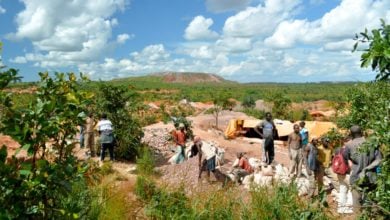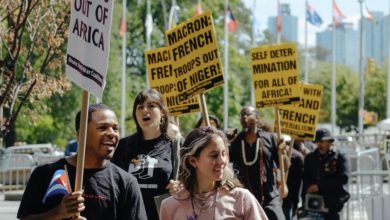 Nelson Mandela in 1999. Photo: Todd Andersen |
Mandela was a founding member of the African National Congress Youth League, the youth group of the main South African liberation organization. In 1961, he founded Umkhonto we Sizwe (“Spear of the Nation”), the ANC’s armed wing.
Nelson Mandela’s release was the culmination of decades of struggle against the racist apartheid system in South Africa. Under apartheid, Blacks had no political rights whatsoever. Black South Africans—about 80 percent of the population—were only allowed to live on “homelands” or “Bantustans,” which made up 13 percent of the land. Whites lived on the richest 87 percent of the land. All aspects of society were completely segregated. All wealth was owned by whites.
Over the decades, Black South Africans developed extensive mass organizations to struggle against apartheid. Again and again, people rose up against racist exploitation. Again and again, government police and soldiers massacred crowds of demonstrators. In 1960, 72 were killed in Sharpeville. On June 16, 1976, at least 600 students were massacred by police in Soweto. For much of the 1980s, Blacks lived under martial law.
As he was released, Mandela addressed an ecstatic crowd. “Our struggle has reached a decisive moment,” he said. “We call on our people to seize this moment so that the process toward democracy is rapid and uninterrupted.” He recalled the words he spoke when he was sentenced to life in prison in 1964: “I have cherished the ideal of a democratic and free society in which all persons live together in harmony and with equal opportunities.”
Fifteen years after his release, has Mandela’s dream been realized?
In 1994, after daily mass demonstrations and a worldwide solidarity movement, the white minority government was forced to submit to democratic elections. For the first time in the country’s history, whites and Blacks voted in the same elections. The ANC easily won the elections and Nelson Mandela became the first Black president of South Africa.
The 1996 constitution
The most significant political outcome of the end of apartheid was the rewriting of the country’s constitution. Nelson Mandela signed the new constitution on Dec. 10, 1996, in Sharpeville to commemorate the 1960 Sharpeville massacre. All the laws enshrining racist minority rule were scrapped.
The 1996 constitution is widely recognized as among the most advanced in the capitalist world. “Non-racialism and non-sexism” are declared to be among the country’s founding values. Indigenous languages which had been suppressed under apartheid were not only recognized but promoted. Discrimination based on sexual orientation is prohibited in the Bill of Rights.
Like the U.S., the South African Constitution recognizes freedom of association. But unlike the U.S., the South African Bill of Rights recognizes the right “to assemble, to demonstrate, to picket”—rights which are routinely curtailed or denied in the U.S.
Advocacy of war or racism are not protected. The right to join a union is enshrined in the constitution. It recognizes the right to housing and a clean environment.
The new constitution represented more than just a change of government, seen routinely in capitalist countries. It marked the transformation of the entire political structure of the country.
More than that, the once-disenfranchised Black majority now controls the political structure of the country. The racist Nationalist Party, which held power from 1948 to 1994, is essentially nonexistent. In the 2004 National Assembly elections, the ANC won nearly 70 percent of the seats.
The South African Communist Party calls the political transformation a “National Democratic Revolution.”
 South Africans protest against enforced teaching of Africaans in Cape Town’s segregated schools under apartheid. Photo: AFP/Getty Images |
Despite the transformation of the political system in South Africa, there are still fundamental contradictions in the society. Private ownership of the means of production remains. Wealth remains in the hands of a few.
The basic social indicators in South Africa paint a bleak picture. The figures for unemployment in 2004 were at 31 percent. Around 50 percent of the population lives in poverty.
The economy remains largely in the hands of the former white ruling class. According to Johannesburg’s City Press (May 11, 2003), 98 percent of executives in privately owned South African companies in 2002 were white.
In 1995, immediately following the end of apartheid, whites controlled over 80 percent of the country’s farmland. That figure remains unchanged today. (AFP, Oct. 5, 2004)
The ANC government in South Africa has made an effort at what it calls “Black Economic Empowerment.” This project, which began in 2002, is designed to increase Black ownership of private property. But it is not designed to address the social conditions that affect the vast majority of Black South Africans.
The tripartite alliance
Many of these contradictions are formalized within the government itself. Since the days of the anti-apartheid struggle, the ANC has had a close alliance with the South African Communist Party and the Congress of South African Trade Unions. These three organizations now form what is called the Tripartite Alliance. SACP and COSATU play key roles within the ANC government.
The ANC is the broadest of the three organizations. It has members from all classes, including members and aspiring members of the bourgeoisie. COSATU, as a union federation, is dedicated to advancing workers’ economic interests.
The SACP is dedicated to socialism, although it sees its role now as a partner in a “multi-class project.” “Any engagement with existing capital and any opportunities for emerging Black capitalist strata must be strategically premised upon the development of productive forces, job creation and eradication of poverty, as overarching and fundamental objectives of the National Democratic Revolution,” according to General Secretary Blade Nzimande. (Umsebenzi Online, Dec. 15, 2004)
This situation has generated political contradictions that reflect the multi-class character of the political leadership of the ANC. The ANC government has been committed to a neoliberal economic program favored by the International Monetary Fund. Basic utilities have been privatized.
Representatives of the working class within the bounds of the Tripartite Alliance find themselves trying to reconcile interests that are fundamentally irreconcilable. What this has meant so far is tying the fate of the working class to the capitalist class and the development of capitalism. This is a dead end.
The struggle continues
True equality—social equality—for Black South Africans cannot take place within the bounds of capitalism. That is the main challenge facing revolutionaries in South Africa. It is the reason that communism remains alive in the fields and mines throughout South Africa today.
The seeds of the new South Africa can be seen today in the demonstrations of landless peasants for land redistribution. They can be seen in the strikes and workers’ demonstrations demanding living wages. The victory of those struggles can only be accomplished by taking over the wealth held by the white ruling class and reorganizing society on the basis of the needs of the vast majority.
Only then will Mandela’s dream be fully realized.
Articles may be reprinted with credit to Socialism and Liberation magazine.




